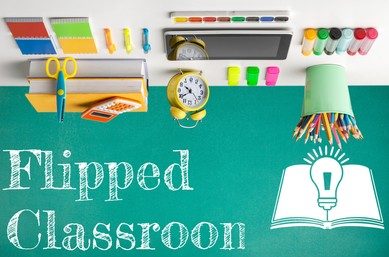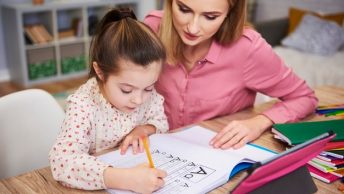Schools and other educational institutions were pushed to transfer their teaching online in the early days of the COVID-19 pandemic, often without warning or training for instructors. As a result, teachers and students are getting into the swing of teaching and studying from home now that it’s been a few months. It’s also a good time to experiment with new teaching strategies, particularly those that perform well with remote learning.
What is flipping the classroom?
The term “flipped classroom” refers to a specific instructional technique. Flipped Classroom’s basic idea is to flip the typical educational arrangement by offering instructional materials outside the classroom, generally as online material. It brings more physical tasks into the classroom, including formerly considered homework and group work. Students in a flipped classroom view online lectures, participate in online conversations, or conduct research at home. Students work on projects, participate in debates, and solve problems in class with the teacher’s help.
The teacher is the primary focus of the instruction in a traditional classroom. They are typically the ones who deliver new material to students through a lecture or presentation and coach them through practice tasks. In addition, students must answer questions, write essays, or complete projects as homework.
Flipped learning is a unique approach to education. It’s a pedagogical strategy in which direct instruction transfers from the group to the individual learning environment. The instructor directs students as they apply concepts and engage creatively in the subject matter in the resulting group area, which is converted into a dynamic, interactive learning environment.
To put it another way, flipping the classroom is a method of teaching that flips the usual learning structure on its head. Rather than delivering a new learning concept in class, teachers prepare a presentation of the information and distribute it to students to watch or read prior to class. The remainder of the class period is devoted to group activities, class discussion, and peer-to-peer collaboration.
What are the benefits of a flipped classroom?
There are various advantages to using the flipped classroom method. This student-centered approach gives teachers more time to evaluate comprehension, respond to questions, and clear up any misunderstandings pupils may have about a new topic.
It means that instead of spending class time explaining the fundamentals of a new topic or idea, you may use your contact time to assist students in putting their new knowledge into practice. Moving direct instruction outside of class time also frees up time in the classroom to focus on creating a dynamic learning environment with plenty of differentiation opportunities.
There are numerous advantages for students as well! They will become active participants in their own education rather than passive recipients of knowledge. Flipping the classroom enables students to take charge of their own education, allowing them to develop the kind of self-discipline necessary for lifelong learning. Exam outcomes, student engagement, and teacher-student communication have all been demonstrated to improve in a flipped classroom.
Why flipped classrooms work for distance learning?
Because students are already doing so much learning from home, distance learning is a great opportunity to check out the flipped classroom. As the teacher-student interaction transforms from an instructional to a collaborative model, it will strengthen and improve your
relationship with your students. This can also aid with motivation. It makes for a more dynamic and interesting online lesson when your class time is focused on the practical application of ideas, student knowledge, and peer-to-peer communication.
With remote learning on the rise, it’s never a bad idea to experiment with instructional approaches that enable students to learn independently.
In three simple steps, learn how to flip your classroom.
So, there are strong reasons to try out the flipped classroom method – but how do you go about doing so? To get you started, here’s a brief breakdown.
- Prepare your subject topic for independent study.
In advance of your online class, prepare the information you want your students to study. It’s critical to think about the best manner to provide this information. Is it through video? Is it possible to do so using a text extract? Is it better to present it as an infographic or a podcast? Maybe it’s a mix of all of the above.
Although video is the most popular type of direct education, there are many more possibilities. Between five and 10 minutes is the most effective video duration. Consider how you may make your presentation more interesting and inventive. You’ll end up with a terrific bank of your own video materials thanks to Oryx Learning’s amazing instructional videos, such as how to implement and use virtual manipulatives for mathematics.
- Motivate your students to study for class.
The success of a flipped classroom is determined by the ability of your pupils to adapt correctly to preparing for class, which might cause teachers to be hesitant. There are, however, a few tactics you might use to excite your children.
You could check-in the day before the session to remind students to prepare for the lesson by reviewing the content beforehand. Another alternative is to inform students that the class will begin with a brief quiz on the content they have already learned. You could also request that they develop a list of questions to ask on the subject. You might also invite your pupils to come up with specific examples to bring to class and share with their classmates if the direct lesson is explaining a subject.
- Plan your class time to support and deepen student understanding
It’s a good idea to review the topic at the start of your class, giving students the chance to raise any questions that arise during their preparation for class. Then, during class, incorporate activities that encourage active learning, such as group work, discussion, presenting student-created content, debates, and project work.
Active learning activities not only make your online lessons more engaging but also help students build 21st-century skills by giving them more time to think critically, communicate creatively, and improve their information and technology literacy.
How does Oryx Learning help with the flipped classroom for distance learning?
Oryx Learning is an interactive learning platform that assists children in enhancing their scholastic development by including them in a variety of learning and problem-solving activities. Oryx learning is unique as it improves students’ learning capacities by limiting the amount of time they have to answer questions. In addition, the curriculum not only provides study aids but also practice questions with guided tutorials, solved example problems with answers and solutions. Many teachers endorse this platform since it is simple to use.
Both teachers and students will discover useful Math resources at Oryx Learning. Creating a pleasurable learning environment Math practice exercises, tests, instructor resources, and a personalized learning experience that allows learners to grow at their own pace are all available.
ORYX Learning allows teachers to effortlessly track their students’ academic development. In real-time, the Analytics tool effectively monitors progress, strengths, weaknesses, areas of interest, and bottlenecks. Oryx learning reports are intended to motivate students to accomplish more while also providing important information to help them overcome their deficiencies. Teachers can also quickly assign the topic or skill their students need to practice. In addition, it assesses the individual elements of a topic or skill and provides a comprehensive and extensive analysis of individual performance.
Even when kids are in class, technology will continue to play a role in their learning. This will aid in maintaining consistency. For example, if schools are briefly closed, kids will not miss instructional time because of the technology routine. In addition, students can collaborate online because most group work does not comply with social distancing.
The online environment is demanding for most teachers and is not sustainable, trying to teach every lesson in a face-to-face. As incorporated with Oryx Learning, flipped learning allows students to work individually while still ensuring that when classes do meet online, they can collaborate and work together more efficiently.







